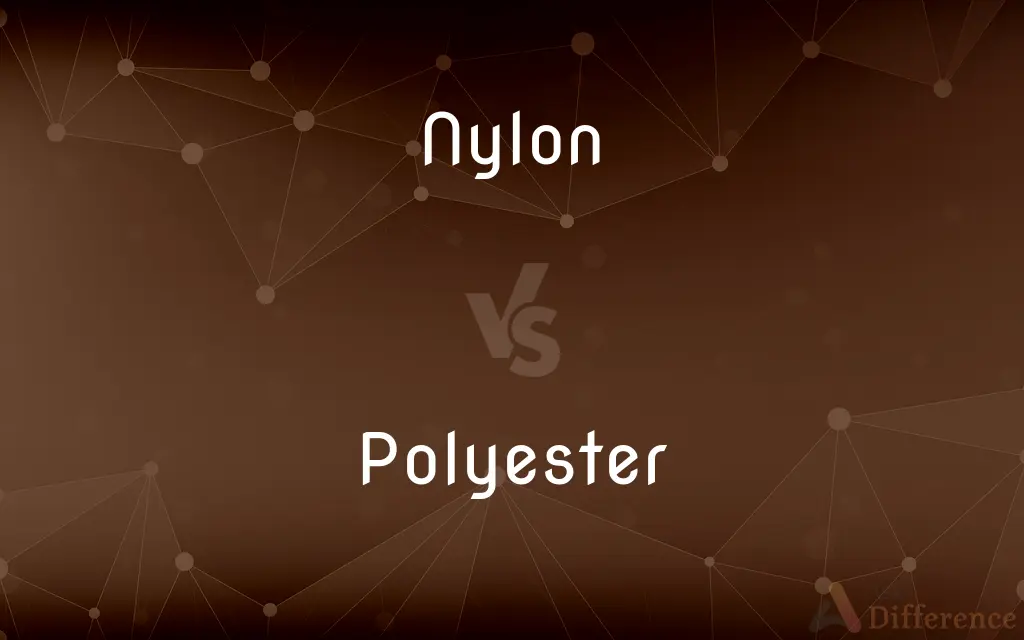Nylon vs. Polyester — What's the Difference?
By Tayyaba Rehman — Updated on September 25, 2023
Nylon is a synthetic polymer derived primarily from petroleum, known for its strength and elasticity. Polyester, also synthetic, is made from ester monomers and is prized for its durability and resistance to environmental conditions.

Difference Between Nylon and Polyester
Table of Contents
ADVERTISEMENT
Key Differences
Nylon and Polyester are two distinct types of synthetic polymers commonly used in various applications, from fabrics to industrial materials. Nylon, introduced by DuPont in the 1930s, is characterized by its exceptional strength, elasticity, and softness. Its attributes make it a favored choice for products like hosiery, parachutes, and ropes. In contrast, Polyester, which came to prominence in the 1940s, boasts durability and excellent resistance to various environmental factors, including UV radiation.
In the textile industry, both Nylon and Polyester are staples due to their unique properties. Nylon's smooth texture makes it comfortable against the skin, often chosen for intimate wear or athletic clothing. Polyester, on the other hand, with its ability to retain shape and resist wrinkles, is frequently found in everyday apparel, home furnishings, and outdoor gear.
When considering environmental impact, Nylon and Polyester have differing concerns. The production of Nylon involves a significant amount of water and releases nitrous oxide, a potent greenhouse gas. Polyester, although more energy-intensive in its production, can be recycled more easily and is often made from recycled materials, such as PET bottles.
In terms of care and maintenance, Nylon and Polyester diverge again. Nylon is sensitive to heat and might melt if exposed to high temperatures, requiring delicate care when ironing or drying. Polyester, resilient and less heat-sensitive, can generally withstand regular washing and drying cycles without significant wear.
Comparison Chart
Origin
Introduced by DuPont in the 1930s
Came to prominence in the 1940s
ADVERTISEMENT
Primary Properties
Strength, elasticity, softness
Durability, environmental resistance
Environmental Impact
Consumes significant water; releases nitrous oxide
Energy-intensive but recyclable
Common Uses
Hosiery, parachutes, ropes
Everyday apparel, home furnishings, outdoor gear
Care Sensitivity
Heat-sensitive; requires delicate care
Less heat-sensitive; withstands regular washing
Compare with Definitions
Nylon
Frequently used in textiles due to its soft texture.
The jacket's Nylon fabric ensures a comfortable fit.
Polyester
Widely used in everyday apparel and home furnishings.
The Polyester curtains are both stylish and durable.
Nylon
A synthetic polymer known for its elasticity and strength.
Nylon stockings are popular due to their smooth feel and durability.
Polyester
Noted for its ability to resist various environmental conditions.
The Polyester tent stood firm against the heavy rain.
Nylon
Often chosen for applications requiring high tensile strength.
The climbing rope, made of Nylon, can support heavy loads.
Polyester
A synthetic fiber made from ester monomers.
Polyester shirts are known to resist wrinkling.
Nylon
Sensitive to high temperatures and may melt if exposed.
It's advised not to use a hot iron directly on Nylon garments.
Polyester
Often made from recycled materials, such as PET bottles.
The Polyester fill of the jacket is sourced from recycled plastic bottles.
Nylon
Derived primarily from petroleum and introduced by DuPont.
The introduction of Nylon by DuPont revolutionized the textile industry.
Polyester
Polyester is a category of polymers that contain the ester functional group in every repeat unit of their main chain. As a specific material, it most commonly refers to a type called polyethylene terephthalate (PET).
Nylon
Nylon is a generic designation for a family of synthetic polymers composed of polyamides (repeating units linked by amide links). Nylon is a silk-like thermoplastic, generally made from petroleum, that can be melt-processed into fibers, films, or shapes.
Polyester
A synthetic resin in which the polymer units are linked by ester groups, used chiefly to make synthetic textile fibres.
Nylon
Any of a family of high-strength, resilient synthetic polymers, the molecules of which contain the recurring amide group CONH.
Polyester
Any of numerous synthetic polymers produced chiefly by reaction of dicarboxylic acids with dihydric alcohols and used primarily as light, strong, weather-resistant resins in boat hulls, textile fibers, adhesives, and molded parts.
Nylon
Cloth or yarn made from one of these synthetic materials.
Polyester
A wrinkle-resistant fabric of fibers made from any of these resins.
Nylon
Nylons Stockings made of one of these synthetic materials.
Polyester
Any polymer whose monomers are linked together by ester bonds
Nylon
Originally, the DuPont company trade name for polyamide, a copolymer whose molecules consist of alternating diamine and dicarboxylic acid monomers bonded together; now generically used for this type of polymer.
Polyester
A material or fabric made from polyester polymer
Nylon
(in the plural) A stocking originally fabricated from nylon; also used generically for any long, sheer stocking worn on a woman's legs.
I tore a hole in my nylons while walking home through the woods.
Polyester
Of, or consisting of polyesters
Nylon
(perjoratively, by comparison to silk) A Queen's Counsel, King's Counsel or Senior Counsel who was appointed as a courtesy, rather than on merit.
Polyester
Any of numerous synthetic resins; they are light and strong and weather resistant
Nylon
Any of several thermoplastic polyamide plastics, comprising a family of high-strength resilient synthetic materials, used mostly in fibers.
Polyester
A complex ester used for making fibers or resins or plastics or as a plasticizer
Nylon
A synthetic fabric consisting of fibers of nylon[wn1].
Polyester
Any of a large class of synthetic fabrics
Nylon
Stockings made of a thin form of nylon{2}, especially full-length stockings either sheer of of varying shades.
Polyester
Generally more energy-intensive to produce than other fibers.
Despite its production costs, Polyester remains a preferred choice for many manufacturers.
Nylon
A thermoplastic polyamide; a family of high-strength resilient synthetic materials
Nylon
A synthetic fabric
Common Curiosities
Is Polyester considered environmentally friendly?
While Polyester production is energy-intensive, it can be recycled and is frequently made from recycled materials.
What is Nylon primarily used for?
Nylon is widely used in textiles for its elasticity and strength, often seen in hosiery and athletic wear.
Can both Nylon and Polyester be used in outdoor gear?
Yes, both materials are used in outdoor gear, but Polyester is often preferred for its resistance to UV radiation.
Which material is more durable: Nylon or Polyester?
Polyester generally boasts greater durability and resistance to environmental conditions compared to Nylon.
Are Polyester fabrics breathable?
Polyester fabrics are less breathable than natural fabrics but can be combined with other fibers to enhance breathability.
Why is Nylon sensitive to heat?
Nylon's chemical structure makes it susceptible to melting or deforming under high temperatures.
Can Polyester garments resist wrinkles?
Yes, one of Polyester's key attributes is its ability to resist wrinkles, making it ideal for everyday apparel.
Which material is softer to the touch?
Nylon generally has a softer texture compared to Polyester.
How does the production of Nylon impact the environment?
Nylon production can consume a significant amount of water and release nitrous oxide, a potent greenhouse gas.
Are there recycled options for both materials?
Polyester is more commonly available in recycled options, often sourced from PET bottles. Recycled Nylon is less common but available.
Share Your Discovery

Previous Comparison
Kurta vs. Sherwani
Next Comparison
Hybridization vs. InbreedingAuthor Spotlight
Written by
Tayyaba RehmanTayyaba Rehman is a distinguished writer, currently serving as a primary contributor to askdifference.com. As a researcher in semantics and etymology, Tayyaba's passion for the complexity of languages and their distinctions has found a perfect home on the platform. Tayyaba delves into the intricacies of language, distinguishing between commonly confused words and phrases, thereby providing clarity for readers worldwide.















































